|
NINE
Christmas Influence Around the World
Christmas reaches far beyond an American tradition. It is a Worldwide affair. Its influences and its pangs have not been contained to one locality. It has seeped into almost every country, race, and religion. And though it seems like Christmas was based on Christian intent, in and around the world the birth of Christ has little, if anything, to do with the love and adoration mankind is bestowing on this spirit.
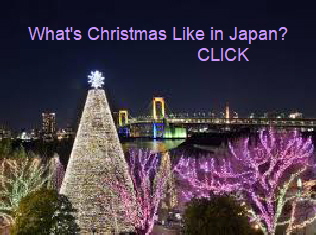 JAPAN JAPAN
For Japan, Christmas has come to mean big bucks, and the spirit of Santa Claus has found his home among the hearts of the Japanese. Meh-dee Ku-dees-mass (Merry Christmas) can be heard ringing out during the holiday as a customary season's greeting in a nation where Christians are a one percent minority. Christmas is much like Japan's own traditional year-end holiday. Merchants bring in about two billion dollars worth of gross sales. The Japanese have done just as well as the Americans have in turning this season into a gala affair.
A small number of Japanese attend mass on Christmas Eve - perhaps a few thousand - but tens of millions flock to shopping centers, markets, restaurants, and elaborate hotels to ritualize an occasion represented by the clang of a cash register. Christmas carol’s set the mood in department stores everywhere and offer Christmas cards in six languages, in many creative styles. Some are decorated with artificial fir trees or holly. Others have miniature animals fashioned in red and green attire. Some of the more affectionate cards include small compact disc records, known as "CD cards". They play favorite Christmas songs, recite love stories, or captivating bedtime tales.
Because of Japan's high technology, Christmas cards have become a big hit. They do almost everything from standing up to singing to flickering on and off. There is even a card that unfolds into an upright Christmas tree with a two-tune repertoires such as "Rudolph the Red-nosed Reindeer" and "Santa Claus is Coming to Town". The songs are stored on a tiny, integrated circuit which is activated by a light sensor when the card is opened.
The cost of these fancier cards is four times more than the standard conventional ones but sales of every kind of Christmas card are booming more than any other time in the past. The message "Season's Greeting," puts the spirit on a neutral ground. An appropriate approach for a country where Buddhism and indigenous Shinto faiths are more common. Though Christmas is not a national holiday, the non-Christian Japanese still enjoy all the parties, gifts, and special foods.
Christmas trees are a tradition in Japan increasing at a steady pace each year. Like America they can be purchased at local supermarkets, but those found in neighborhoods where American or Europeans live sell much better. Christmas cakes are shipped in from Germany, England, and France. Even Santa has been imported but instead of flying in on his sleigh, a jumbo jet better suits his ritzy style.
Most children don't know what to make of the big man in red who apparently speaks no Japanese but is quite fluent in Finnish. Other children have come to an awareness that Santa is the gift-bearer, and for one special little boy Santa offered him a trip to see real white snow as his gift. The boy declined Santa's offer in favor of a video game. Children are catching on at a steady pace, too.
 Japan's December holidays fit in nicely with Christmas. Bonenkai is their year-end party, and Oseibo is a time for gift exchange. Like Christmas, they both signify an expression of gratitude and best wishes for the new year. With all three of these celebrations mingled in and around each other it makes for more fun and gaiety, as well as more profit for the merchants. Japan's December holidays fit in nicely with Christmas. Bonenkai is their year-end party, and Oseibo is a time for gift exchange. Like Christmas, they both signify an expression of gratitude and best wishes for the new year. With all three of these celebrations mingled in and around each other it makes for more fun and gaiety, as well as more profit for the merchants.
Japanese retailers have clued in to a social problem that America has suffered for decades and now they offer a logical solution: stress gifts. One might include a portable tape recorder or a compact disc player with relaxing classical music or new-wave tunes. These are intended to put people at ease, most especially those in the tense world of business.
No matter how one perceives Christmas in Japan, it is indeed looking more and more like a reflection of America's image of the season. And its people are no doubt beginning to feel the spirit's touch of what it has to offer. (High Technology Christmas Cards Big Hit with Japanese Shoppers," News Review, 25 December 1988.)
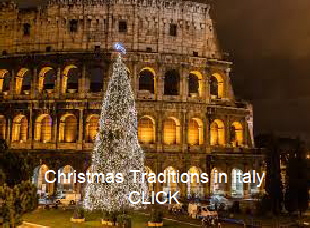 ITALY ITALY
Christmas in Italy is one of elaboration. As in most Roman Catholic countries Christmas is a mixture of religious observance and pagan customs. Their dinner often consists of fish (the symbol of Christ), and might include panettone, a delectable sweet breadlike cake filled with fruit and nuts with powdered sugar sprinkled atop. It is a recipe that dates back to the days of the Roman Empire.
Christmas is mingled in with the Feast of Saint Nicholas (December 6) and Twelfth Night (January 6) the Feast of Epiphany, when the celebrations thus concludes. Gift-giving does not come to an end on Christmas day. Children wait 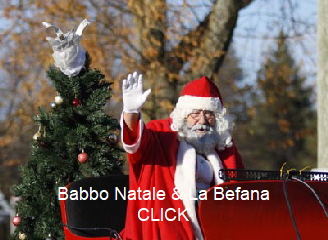 for the good witch, La Befana, to slip down their chimney or stovepipe on Epiphany to leave them sweets if they have been good, or coal if they haven't. Families set up a presepio or manger, and many are incredibly striking with hundreds of different figurines. Almost every church displays one as they compete with each other for the grandest. for the good witch, La Befana, to slip down their chimney or stovepipe on Epiphany to leave them sweets if they have been good, or coal if they haven't. Families set up a presepio or manger, and many are incredibly striking with hundreds of different figurines. Almost every church displays one as they compete with each other for the grandest.
Christmas cards in Italy don't appear to be as popular as they are in some countries, although they do exist. Most likely one would portray a Nativity scene, a bit weathered as it may be, depicting a medieval Roman tavern rather than the customary Bethlehem stable.
Santa Claus made his way into Italy a little less rotund, more of an elegant gent with a finer cut red suit than the Santa of America. Children know him as Babbo Natale. Although Santa Claus and Christmas trees are newcomers, both seem to be adapting quite well.
The fact that these two have made their way into Italy is proof of the spirit's arrival. Many claim that the internationalism and commercialism that has seeped in from American Christmas traditions cannot compare to the adoration for an Italian saint or an artisan's crèche.
Italy seems to be one place that through two-thousand years of change has not lost its roots. Less than half a century ago this awe-inspiring country was a backward agricultural society. Today it is a flourishing industrial nation.
In Rome, Christmas appears everywhere when the spirit is in the air. The luminous lit trees line streets with a radiance that touches the very heart of the Eternal City. The gradual increases of Christmas trees has become common enough that people don’t feel as if they are an unfamiliar adornment anymore. Some may remember a time when there were no Christmas trees, when a concert of crèches held the full spot light. Known to have been an Italian design, crèche are still a big success and have improved with age since 1223. Nearly eight centuries of magnificent creations remain to draw devoted attention.
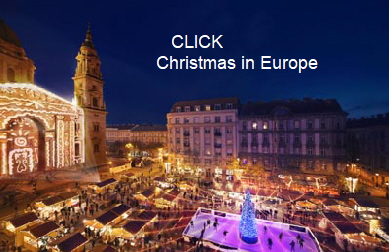 EUROPE EUROPE
Christmas in Europe is not quite the same as it is in America. Many American traditions came over from Europe with the European immigrants who were settling into the New World. The most typical examples would be gift-giving, singing carols, and trimming the tree. But in many respects, Christmas differs in both worlds.
Santa Claus is not as popular as Saint Nicholas or Father Christmas. The image of the medieval bishop wearing his red robe and flowing white beard with shepherd’s staff in hand still travels with his diabolic servant. Father Christmas' little companion carries a switch in one hand with a list of children who have been bad or good in the other.
Dutch and Belgian children are accustomed to receiving gifts on the Feat of Saint Nicholas. In the Netherlands, Sinterklaas gallops across the country on a white charger, while children view his flight on nationwide television. After his purpose is fulfilled he thus boards a steamer for Spain - his presumed residence for the rest of the year.
Some historians believe that the Christmas tree originated in Germany about the eighth century. They tell us that Prince Albert of Germany brought this tradition to England shortly after his marriage to Queen Victoria in 1840.
The Greeks have found their own tradition by decorating ships. One Christmas ship is a model of a caique, Mediterranean sailboat bedecked with flags and lights. It is placed on mantles and window sills as an ornament. The Christmas spirit has many creative ideas to make the Season a memorable event in which to pass on to future generations, and such small objects as these can instill a lifetime of memories.
U.S.S.R.
In the Soviet bloc - since communist authorities frown on Christmas - people have their own winter holiday where Father Frost takes Santa's place. Father Frost also has a helper known as the Snow Maiden. The birth of Christ may not be mentioned in Czechoslovakia, but like Christmas the Soviet bloc nation celebrates their firmly established "Feast of Love and Peace". Christmas to the Czech is called Vanoce with no Christian connotation intended. All the same, churches fill up for a midnight service on the Eve of Christmas and one might also hear people asking children what they received from Jesisek. The infant Jesus does bring Czech children their gifts. In the Soviet Union, however, December 25 is just another day.
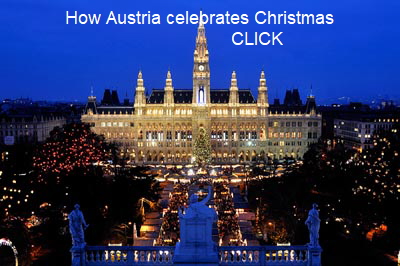 AUSTRIA AUSTRIA
Austrian children know Saint Nicholas as Nikolo. He brings them gifts and chocolates on December 6 (Saint Nicholas Day), and parents caution their children about the nasty little red devil called Kraumpus who travels with Nikolo armed with a birch switch. Christkinl, or Little Christ Child, is the one who brings gifts on Christmas Eve. He sneaks into the house placing the presents under the tree while the family waits eagerly in another room. One past superstition that still lingers in this country happens on New Year's Eve. It's been common practice to take molten lead and toss it into the snow so supposedly it will foretell the future by the way the lead quickly assumes its formation.
BRITAIN
One may not see much difference between Britain's Christmas and America's. In many ways they are indistinguishable. Santa Claus is becoming as nearly renowned as their Father Christmas. Instead of the American way - leaving milk and cookies - British children put out a glass of sherry and a slice of mince pie for him. Pantomime is one of Britain's popular traditions where a boisterous audience participates in plays.  Such fairy tales as "Mother Goose," "Jack in the Beanstalk," and "Cinderella" are most favored. The fun of it is the sheer folly of featuring a dame (a man dressed as a woman) and a principal boy (a young woman dressed as a boy). Such fairy tales as "Mother Goose," "Jack in the Beanstalk," and "Cinderella" are most favored. The fun of it is the sheer folly of featuring a dame (a man dressed as a woman) and a principal boy (a young woman dressed as a boy).
The abiding joys of Christmas in Britain revolve around stores brimming with exquisite gifts, boutiques windows full of delectable treats to entice shoppers, and cheerful choral music to fulfill the hearts desire. At Trafalgar Square a huge Norwegian tree glows with splendor. On most every home a holly wreath adorns the door. Garlands of red, green, and gold tinsel sparkle in the windows of every pub in sight. The crowds in London's Oxford Street are so crushing at times that one-way walking paths are instituted. Commercialism seems to have taken the edge over religious observance, but one can still find an hour or two of pleasure with a choir.
 When people raid the grocers and wine merchants in a madness to prepare for the feast of Christmas Day the neighborhood poulterer may put turkey orders down in numbers and advice people to pick up their order on December 23. The lines can sometimes stretch clear around the corner. The Post Office receives mail for Santa in care of The Royal Mail. They remind children to get their letters in early because Father Christmas lives a very long way off. The Post Office receives greater than two hundred thousand letters from British children each year and these are answered from Santa's faithful servants. When people raid the grocers and wine merchants in a madness to prepare for the feast of Christmas Day the neighborhood poulterer may put turkey orders down in numbers and advice people to pick up their order on December 23. The lines can sometimes stretch clear around the corner. The Post Office receives mail for Santa in care of The Royal Mail. They remind children to get their letters in early because Father Christmas lives a very long way off. The Post Office receives greater than two hundred thousand letters from British children each year and these are answered from Santa's faithful servants.
It's not unusual for the British Broadcasting Corporation to interrupt the evening news to show Father Christmas gliding across the Arctic Circle behind his team of reindeer. All of this is said to be an experimental early start to get ahead of holiday traffic, though children should not, all the same, expect their gifts before December 25.
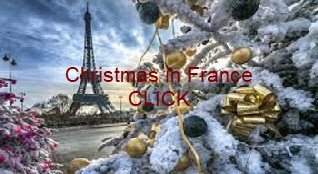 FRANCE FRANCE
To the French, Pere Noel (Father Christmas) may be a newcomer but at one time he was known as Pere Fouettard, the Whipping Father. He was accompanied by Saint Nicholas as he made his rounds on December 6. The story goes on that when Saint Nicholas was rushing about delivering gifts to the children, his fierce traveling companion was out punishing those who had been bad all year. Pere Fouettard is now a gentle gift-bearer called Pere Noel.
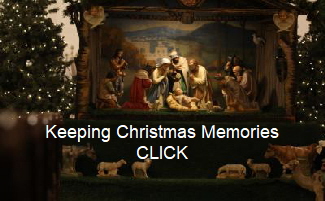 France is also noted for its outstanding crèches. The mangers, with their exquisite figurines, tell the Christmas story. When Father Christmas comes calling he finds shoes instead of stockings to stuff with all his goodies. In Alsace they enjoy the traditional goose; in Brittany it is their famous buckwheat pancakes and sour cream; and in Paris one will find oysters to be very popular. France is also noted for its outstanding crèches. The mangers, with their exquisite figurines, tell the Christmas story. When Father Christmas comes calling he finds shoes instead of stockings to stuff with all his goodies. In Alsace they enjoy the traditional goose; in Brittany it is their famous buckwheat pancakes and sour cream; and in Paris one will find oysters to be very popular.
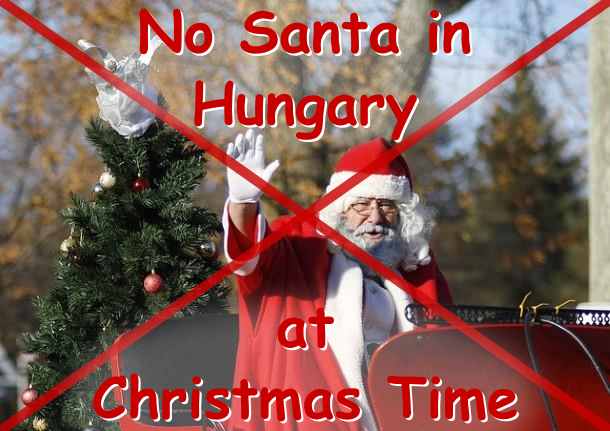 HUNGARY HUNGARY
In Hungary, Christmas 1987 marked a remembrance of one of its most frenzied buying sprees. People hurried to make their purchases before the new year rang in with its price increase. The merchants in this Communist-governed country placed orders for an extra $16 million worth of giftware in an effort to beat the price increase and satisfy the buyers demand. Children are known to go about caroling in shepherds' costumes, generally receiving a small token or perhaps a little something to eat and drink in return for the joy they bring.
IRELAND
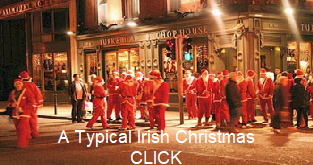 Ireland shares several similar Christmas traditions that Britain and America enjoy. Besides plum pudding there is holly and ivy decorations adorning homes. Ireland also has some of their own traditions where they place a big thick candle on the window sill to flicker for all to see. The light is a symbol of welcome to any traveler in need of warmth and shelter. The idea revolves around Joseph and Mary when they were in search for a place to rest. Ireland shares several similar Christmas traditions that Britain and America enjoy. Besides plum pudding there is holly and ivy decorations adorning homes. Ireland also has some of their own traditions where they place a big thick candle on the window sill to flicker for all to see. The light is a symbol of welcome to any traveler in need of warmth and shelter. The idea revolves around Joseph and Mary when they were in search for a place to rest.
Another ritual one can still find in many parts of Ireland is "Wren Day," a day after the Christmas celebration. People dress up in fancy attire disguising themselves as they go around visiting homes performing songs, dance, and mime in return for only a taste of a little Christmas cheer and perhaps a needed contribution to put toward their town commemorations at night.
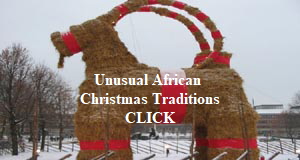 AFRICA AFRICA
In 1988, Santa Claus finally returned to Sowetans, South Africa, after a twelve-year boycott. It is the first time since violent political protests shook South African’s most populous black township in 1976, and again in the the mid 1980s. Now, Christmas has returned without any antiapartheid austerity campaign or consumer boycotts. (Peter Honey, "Sowetans Mark First Christmas in 12 years," Baltimore Sun, December 1988).
But in some of the other Christianized countries of Africa, such as Ghana, the Christmas observance is done in a traditional manner with a bit of native seasoning. Fireworks are popular and a meal consisting of pounded yams called fufu is served. Besides gift exchanging, sharing food with neighbors is customary. The Christmas tree in Liberia is an oil palm decorated with bells instead of the fir.
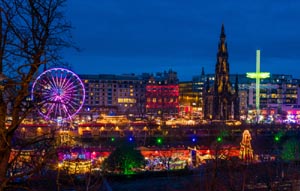 SCOTLAND SCOTLAND
Scotland carries on the old superstitions where the first person to enter a home on New Year's Day brings with them good or bad luck. Luck seems to prevail also where women are concerned. They are presumed to bear the mark of bad luck, as are flatfooted persons and those who squint their eyes.
SCANDINAVIA
The Scandinavians say Christmas last a month because the festivities begin on Saint Lucia's Day. The tradition of the youngest daughter dressing up as Lucia - the patron saint of the blind - opens the door to her parents' sleeping quarters at the break of dawn. With a wreath of burning candles adorned on her head she offers them breakfast in bed with an assortment of special Saint Lucia's buns and cakes gleaming with warmth.
SWEDEN
It's smorgasbord style for Christmas in Sweden where the main family meal consists of sun-dried cod in cream sauce, ham and rice pudding with a special treat hidden inside ... a whole almond. According to popular superstition the one who finds the almond first is surely to be wed before the year's end.
MEXICO
In Mexico, where a tradition is slowly giving way to the full powers of the spirit, families still travel to a friend's home to share each other's warmth and cheer. They are greeted with a prayer before the celebration begins ... a touch of simplicity that still remains. The famous piñatas, paier-mache animals filled with toys and candies, are popular and children enjoy breaking them open to receive their surprise. But sorrowfully the Yule ways are beginning to erode Mexico as the holiday takes on the image of the spirit's trappings.
Christmas trees sell quite well, and cheery carols resound from the radio. Like children most everywhere they flock to see Santa, tell him their wishes, and have a picture taken. Mexico's own holiday traditions continue to survive but no doubt are becoming overpowered by the new ways. Mexico is modernizing and with it is the Christmas celebration. The influences of Americanization is sparking some condemnations. Many people are saddened at the change because they remember Christmas as a humbler time.
 There was a day when there was no Santa, no tree, no glitter and glamour, only a religious celebration that is now degenerating. The posada is one amount many traditions that still exist. It is a pageant reenacting the biblical story of Joseph and Mary in search for an inn. As far back as 1920 these reenactments have been held during the nine days before Christmas. Most every neighborhood puts them on. There was a day when there was no Santa, no tree, no glitter and glamour, only a religious celebration that is now degenerating. The posada is one amount many traditions that still exist. It is a pageant reenacting the biblical story of Joseph and Mary in search for an inn. As far back as 1920 these reenactments have been held during the nine days before Christmas. Most every neighborhood puts them on.
The adoption of American Christmas symbols and rituals reflect the inescapable fact the Spanish-born traditions are under attack from the influence of the spirit. Perhaps old customs are looking more and more impractical these days, but like so many American people it really is good old-fashioned simplicity their hearts still yearn to keep.
LATIN AMERICA
Mangers are so poplar in Latin America that in Costa Rica one might elaborate an entire room. Some, like in Panama, are called nacimiento. They are very intricate entailing waterfalls with green grass and trees as part of the display. One might find Argentineans feasting on their Christmas dinner outdoors on the veranda. They would find the table arrayed with roses and jasmine surrounding cold roast turkey or chicken and all the trimmings. It's customary on Twelfth Night to set fresh water outside to quench the Wise Men's camels thirst on their long journey in search of baby Jesus.
BETHLEHEM
In Bethlehem, where Christmas is said to have begun, thousands upon thousands of Christians flock from around the world to set foot on the Holy Land and spend Christmas where Christ lived his short life on earth. And thousands more truly wish they could. The Church of the Nativity marks the center of where worshipers have journeyed to for nearly two thousand years, with the belief that this is the very spot their Lord was born.
On the twenty-eight Holy Stairs in Rome - brought over from Jerusalem as the once-upon-a-time marble steps ascended to Pilate's palace - faithful believers drop to their knees and slowly crawl to the top, pausing at each step to saver the moment in prayer. They kiss the crucifix of their rosary after it has touched the presumed spot where the blood of Christ flowed from his weary body.
The Church of the Nativity and the Holy Stairs are among hundreds of relics and highly honored objects of worship connected directly to Jesus or many saints. They are known to hold a powerful inspiration for millions of faithful believers. For centuries these relics have had credibility, now they are coming under new scrutiny. It may have begun with the Shroud of Turin when the Roman Catholic Church confessed that scientist determined the burial cloth of Christ was a fake. To discover such startling news over one of the most famous relics of all (in October 1988), has lead to questions about the rest of the churches claims.
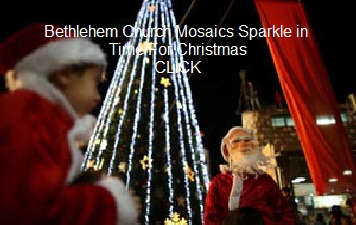 In essence there is no proof that Christ was born on the very spot where the Church of the Nativity was built, as there is no proof that these marble steps ever contained Jesus' blood. We can't even be sure if Jesus tread upon them. Still, people cling to their traditional ways believing in the many cherished linked objects of religious symbolism. The church feels that these objects are more important than questions of authenticity. They believe these relics are a source of strengthening one's faith. They teach that they are a means for one to draw closer to God. In essence there is no proof that Christ was born on the very spot where the Church of the Nativity was built, as there is no proof that these marble steps ever contained Jesus' blood. We can't even be sure if Jesus tread upon them. Still, people cling to their traditional ways believing in the many cherished linked objects of religious symbolism. The church feels that these objects are more important than questions of authenticity. They believe these relics are a source of strengthening one's faith. They teach that they are a means for one to draw closer to God.
Some of the other religious objects the Roman Catholic Church claim to have are; drops of milk from the breasts of the Virgin Mary. About seventy sanctuaries around the world report having these holy droplets. Other items include fragments of the cross; strands of Jesus' hair; His fingernails and tears; as well as at least thirty genuine nails for the crucifix that Christ hung upon. Although the Shroud of Turin has been discredited it nonetheless prevails as a powerful symbol, and church officials have not ruled out that it could still be the work of God. Scientists have their own facts that indicate the cloth was made between 1260 and 1390.
 There is one truth the church claims that we can be sure of: Jesus was born in Bethlehem. This not so little town will always be revered above all others as a great and wonderful historic landmark. In Manager Square a forty foot-high Christmas tree might dazzle the city decorated with red and white balls and a blinking light atop. Like everywhere else, holiday shoppers in the Holy Land also are in a frenzy preparing for the spirit's arrival. There is one truth the church claims that we can be sure of: Jesus was born in Bethlehem. This not so little town will always be revered above all others as a great and wonderful historic landmark. In Manager Square a forty foot-high Christmas tree might dazzle the city decorated with red and white balls and a blinking light atop. Like everywhere else, holiday shoppers in the Holy Land also are in a frenzy preparing for the spirit's arrival.
The traditional Christmas dinner consists of turkey, whole roast sheep, stuffed zucchini and special Arab sweets. As many as fifty relatives might gather together for the feast. Santa would mark the official season’s greeting as he heads the Palestinian Boy Scouts band into Manger Square, right past the acclaimed Church of the Nativity. Other festive events would include Christmas carolers singing, midnight mass, and a Protestant service in the nearby Shepherds' Field.
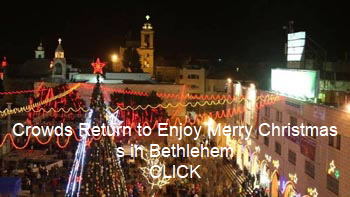 These are but a few of the normal events for the occasion but as of the late 1980s, a turn of events emerged that put a damper over the city, one that might leave its mark on history forever. The headlines read "No Christmas For Bethlehem". These are but a few of the normal events for the occasion but as of the late 1980s, a turn of events emerged that put a damper over the city, one that might leave its mark on history forever. The headlines read "No Christmas For Bethlehem".
Since the 1987 breakout of Palestinian uprising, Christmas in the homeland of Jesus has since been filled with mourning and sorrow. The fanfare is gone, the decorations still neatly packed away, the sound of music dimmed, and Santa has not been allowed in the Holy Land for Christmas ever since. The plaza, usually adorned and jam packed with tourist, looks deserted.
Businesses have taken their toll for the decline of buyers, causing thousands of dollars in profit loss and they may be wondering, as many others, just how long will the spirit remain an outcast. Perhaps only time will tell if it shall ever be welcomed back. 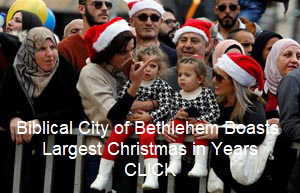 For a town where the King of Peace was born, how unnatural it seems that his birthplace would suffer such a conflict as the one that has spilled over into the 1990's decade. For a town where the King of Peace was born, how unnatural it seems that his birthplace would suffer such a conflict as the one that has spilled over into the 1990's decade.
There is no doubt that the Christmas spirit will continue to flourish as it slowly mingles in with already existing winter celebrations throughout the world. There is no doubt that Santa Claus will be "king" over the many other names this same spirit assumed out of Babylon. What we can expect to see happening around the world are the last formations of one image, one worship, one earthly kingdom belonging to the spirit who is fulfilling his ultimate master plan to conquer your very soul, masked in the name of Christ Jesus.
About Christmas?
About Truth?
Perhaps it's time for you to tell !!
A little deeper insight provided in these videos
The History Channel: The Real Story of Christmas
A & E The History of Santa Claus
(All rights reserved, including the right of reproduction in whole or in part in any form.
Copyright 1990 / ISBN: 0-533-08812-7 / Library of Congress Catalog Card No : 89-90466 (Out-Of-Print)
|